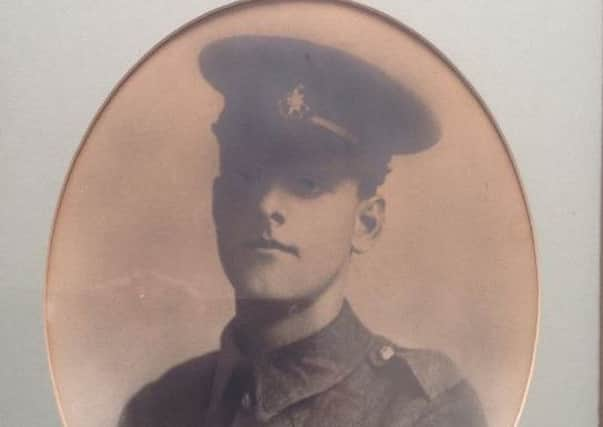East Grinstead's teenage hero of Battle of Boar's Head


One hundred years ago, the Somme, Jutland and Boar’s Head became three of the most bloody, costly battles of the Great War.
The latter struck closest to home, when the 11th, 12th and 13th Battalions of the Royal Sussex Regiment saw more than 1,300 of their number killed, wounded or taken prisoner. The battle, on June 30 1916, became known as The Day Sussex Died.
Advertisement
Hide AdAdvertisement
Hide AdAmong the men who lost their lives was Private James Curtis Jenner, son of William and Fanny Jenner, of Council Terrace. A member of the 13th Battalion, which was almost wiped out during the battle, he was just 19 years old when he died.
His death was recorded in the Sussex and Surrey Courier on Saturday August 12 1916.
Under the heading The Toll Of War, the report read: “Private James Curtis Jenner, of the Royal Sussex Regiment, killed. This young fellow was a son of Mr and Mrs W Jenner, of Council-terrace, with whom deep sympathy is felt, for their soldier son was well known and respected.”
James was a baker’s assistant before the war and was one of eight children – six girls and two boys. His great niece, Christine Adamson, grew up hearing all about her courageous uncle, and her mother always pointed out his name on the High Street war memorial whenever they visited East Grinstead from their home in Copthorne.
Advertisement
Hide AdAdvertisement
Hide AdChristine said: “Uncle Jim, as he was known, was my grandmother’s elder brother and she never spoke of him without shedding a tear.
“Shortly before my grandmother died in 1987, I promised her that I would locate and visit his grave and when the house was cleared, I was given Uncle Jim’s regimental photograph.”
She has made good on her promise, visiting the grave in St Vaast Post Military Cemetery, Richebourg-L’avoue, several times with her mother, daughters and husband. The family plans to visit again on June 30, to honour their uncle and his comrades on the centenary of their death.
Before James’ remains were interred in their final resting place at St Vaast, he, like many others, was buried at another site. His little sister Annie – Christine’s grandmother – was among the first to pay her respects once the Great War was over. Christine said: “My grandmother made the journey across to visit his first grave just after the war. It was the only time she left England and for a girl in her teens to see such desolation must have been awful.”
Advertisement
Hide AdAdvertisement
Hide AdJames’ regimental photograph has travelled all over the world with Christine and her husband, who is a member of the RAF. They are currently based in France and Christine said: “The photograph has prompted many a comment and been admired by military and non-military visitors alike.
“Keeping his photograph with us has kept him as part of the family and his has been a familiar face to my daughters as they grew up in a military family with frequent moves.
“My eldest daughter is 19 now – the same age as Uncle Jim when he was killed – unimaginable.”
Former county archivist, Alan Readman, described how the Boar’s Head tragedy unfolded.
Advertisement
Hide AdAdvertisement
Hide AdIn an article written for the Chichester Observer, he said: “It was the third year of the war on the Western Front.
“Their target was a salient, or bulge, in the German line near the village of Richebourg L’Avoue in northern France. It was known as the Boar’s Head.
“The preliminary artillery bombardment was expected to have destroyed the enemy wire, pulverised their trenches and shattered the morale of the troops.
“The Sussex boys, as they prepared to cross the few hundred yards of No Man’s Land, were told to expect little resistance. In fact, the barrage failed in its objectives, and instead they met withering machine gun fire.”
Advertisement
Hide AdAdvertisement
Hide AdHe added: “The Boar’s Head was a diversionary strategy, intended to draw German attention and resources from the location of the ‘Big Push’, planned to take place further south, on the Somme.
“Yet the week-long bombardment and the build-up of Allied troops gave lie to that ploy and eliminated any element of surprise.
“Again, the failure of the barrage contributed to the scale of the losses. On the first day, Saturday July 1 1916, the worst day in British military history, 19,240 were killed and 38,230 wounded.”
Don’t miss out on all the latest breaking news where you live.
Advertisement
Hide AdAdvertisement
Hide AdHere are four ways you can be sure you’ll be amongst the first to know what’s going on.
1) Make our website your homepage
2) Like our Facebook page
3) Follow us on Twitter
4) Register with us by clicking on ‘sign in’ (top right corner). You can then receive our daily newsletter AND add your point of view to stories that you read here.
And do share with your family and friends - so they don’t miss out!
Always the first with your local news.
Be part of it.